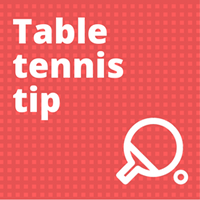Consistency is one of my big things. It plays a big part in all of my coaching sessions. I often challenge players to perform a shot (or sequence of shots) a certain number out of 10. I may set a target of 7 out of 10. If they achieve this, I repeat the exercise with the target of 8 out of 10. I’m only really satisfied if they get 10 out of 10.
Why do a place such a big emphasis on consistency? Fairly obviously, if you are able to perform a shot or a combination of shots with a high level of consistency you’re going to win many more points.
There’s not much use having a devilish spinny serve or a big attacking shot if you can’t execute them consistently. You’ll give away points rather than winning points. This isn’t good table tennis.
Consistency increases confidence
Crucially, consistency massively increases your confidence in playing a shot when it matters most. If you can’t play a shot consistency in practice, you are far less likely to use it in a competitive match.
I know this from my own game. My forehand topspin is a lot more consistent than my backhand topspin. So which shot do I use more during a competitive match? My forehand topspin. On a good day, I will get 90%+ success rate. Even on a bad day, I know I’ll get 60%-80% forehand topspins on the table. This gives me confidence and regardless of the opponent or match, I’ll always try to use my forehand topspin because I know I’m likely to make the shot.
However, my backhand topspin is a different story. It’s nowhere near as consistent as my forehand. If I’m winning and relaxed then I’m prepared to take a risk with my backhand. If the score is close or if I’m feeling under pressure, my backhand topspin goes into hiding. Actually, it goes into its nuclear bunker, locks the door and swallows the key. There is no way it’s coming out! Because my backhand topspin is not consistent enough, I lack confidence to use it when under pressure.
Practice makes perfect
It all comes down to practice. The only way to improve consistency is to repeatedly practice the same shot over and over again.
Over the years, I must have practiced my forehand topspin 10 times more than my backhand topspin. So it’s not really a surprise that my forehand is 10 times more consistent. (I’m probably being a bit harsh on my backhand. It’s not as bad as I’m making out. And it has improved a lot recently with some focused practice).
To improve consistency, it’s easier to start with lots of regular drills (drills where you know where the ball is going to be placed). These drills help you get your technique right. When you start achieving high levels of consistency during regular drills, you should progress to irregular drills (drills where you don’t know where the ball is going to be placed). Irregular drills more closely mirror what happens in match-play.
Consistency doesn’t mean slow
Often people equate consistency with being steady. If a player is labelled ‘consistent’, the implication can sometimes be that the player is a little bit safe. They play without speed or power. They don’t take risks. They just keep the ball on the table and wait for the opponent to make mistakes. They’re just nice and steady.
But consistency doesn’t have to mean slow and steady. Consistently means executing the same shot, however slow or fast, repeatedly without error. Who is the most consistent player in the world right now? Probably Ma Long. Is he slow? No! Ma Long is ridiculously fast and powerful. He is also ridiculously consistent. This is why he is number 1 in the world.
Can you pass my consistency test?
I want players I coach (and you reading this) to get excited about consistency. It’s a massive ingredient of what makes someone really good at table tennis.
Think about the shots you use in your own game, e.g. forehand topspin down the line, backhand flick cross-court, forehand smash, short backspin serve etc etc etc. Would they pass my consistency test? Can you play the shot (of sequence of shots) 10 times without error? If yes, well done! Your consistency is good. To progress, try playing with a bit more speed, spin or power and repeat the test.
If you don’t get 10 out of 10, there’s only one thing you can do… practise more!
Take your game to the next level
If you are serious about improving your table tennis skills, I recommend you join Tom’s TT Academy. In my online academy, you will get access to a wide range of coaching content, including:
- in-depth courses
- training drills
- video analysis
- fitness videos
- robot training videos
- member discussions
- skill challenges
- and lot’s more!
You can access all this content for less than £1 per week. New content is added regularly. Join hundreds of table tennis players around the world today at tomsttacademy.com

